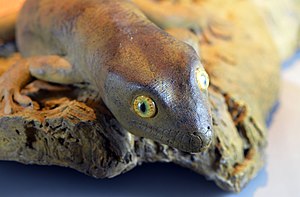Kawekaweau gecko
| Kawekaweau gecko | ||||||||||||
|---|---|---|---|---|---|---|---|---|---|---|---|---|

Kawekaweau gecko ( Hoplodactylus delcourti ) |
||||||||||||
| Systematics | ||||||||||||
|
||||||||||||
| Scientific name | ||||||||||||
| Hoplodactylus delcourti | ||||||||||||
| Bauer & Russell , 1986 |
The Kawekaweau gecko ( Hoplodactylus delcourti ) is an extinct gecko species from New Zealand . With a total length of over 60 cm, it is considered the largest gecko species that has ever been discovered.
history
The Kawkaweau gecko is only known from a single specimen, the male holotype ; it bears the copy number MMNH 1985-38 and has been preserved by drying. It was discovered by Garth Underwood , Anthony Russell and Alain Delcourt in the collections of the Musée d'Histoire Naturelle de Marseille , where the gecko was kept for a long time without precise labeling. In fact, the specimen was on public display for years until its importance was recognized. It was first described in 1986 by Bauer and Russell. The specific epithet delcourti honors Alain Delcourt.
Due to the lack of labels, no statements can be made about the year of discovery or the exact origin of the species; the specimen probably found its way into the museum's collection in the 19th century.
origin
Exact information on the distribution is not possible. However, the other, related Hoplodactylus species are only found in New Zealand, and Maori tales include a giant lizard named kawekaweau . This is probably inspired by Hoplodactylus delcourti . Thus, the distribution area can be limited to New Zealand.
features
The only known specimen to date has a head-to-trunk length of 37 cm. The head is quite short and broad, the muzzle is flat. The trunk is strong, the gecko had short legs. The tail is 25.2 cm long and cylindrical in cross section. The scales are quite small and grainy.
The specimen copy of Hoplodactylus delcourti is yellowish-brown and is marked with dark reddish-brown vertical stripes on the upper side of the body. The coloration was probably greatly changed with the less gentle conservation method - in life the gecko was probably light brown with dark red vertical stripes and a cream-colored underside of the body.
die out
The IUCN classifies the kawekaweau in the category "extinct" ( extinct ), because other than the type specimen no more have been known. The extinction, which probably occurred in the middle of the 19th century, is due on the one hand to the loss of forests through clearing, and on the other hand to the rats introduced by European settlers to New Zealand to hunt the young of the Kawekaweau gecko.
Individual evidence
- ↑ a b c d Aaron M. Bauer, Anthony P. Russell: Hoplodactylus delcourti n. Sp. (Reptilia: Gekkonidae), the largest known gecko. In: New Zealand Journal of Zoology. Vol. 13, No. 1, 1986, ISSN 0301-4223 , pp. 141-148, doi : 10.1080 / 03014223.1986.10422655 , digitized version (PDF; 1.9 MB) ( Memento from February 2, 2014 in the Internet Archive ).
- ^ A b Aaron M. Bauer, Anthony P. Russell: Hoplodactylus delcourti (Reptilia: Gekkonidae) and the Kaweaweau of Maori Folklore. In: Journal of Ethnobiology. Vol. 7, No. 1, 1987, ISSN 0278-0771 , pp. 83-91, digitized version (PDF; 1.4 MB) ( Memento from November 7, 2013 in the Internet Archive ).
- ↑ Hoplodactylus delcourti in the endangered Red List species the IUCN 2010. Posted by: World Conservation Monitoring Center, 1996. Retrieved on November 24, 2014 ..
Web links
- Hoplodactylus delcourti in The Reptile Database
- Hoplodactylus delcourti in the endangered Red List species the IUCN 2010. Posted by: World Conservation Monitoring Center, 1996. Retrieved on November 24, 2014 ..
- New Zealand Lizards (skinks & geckos)